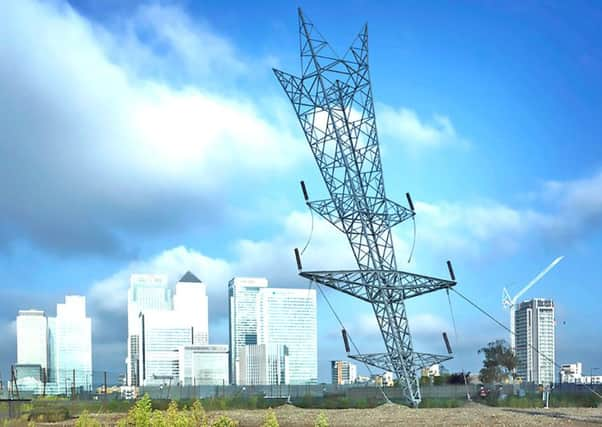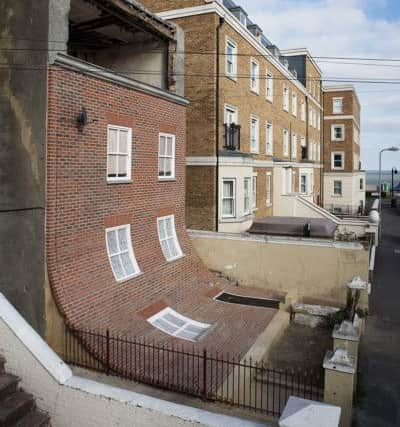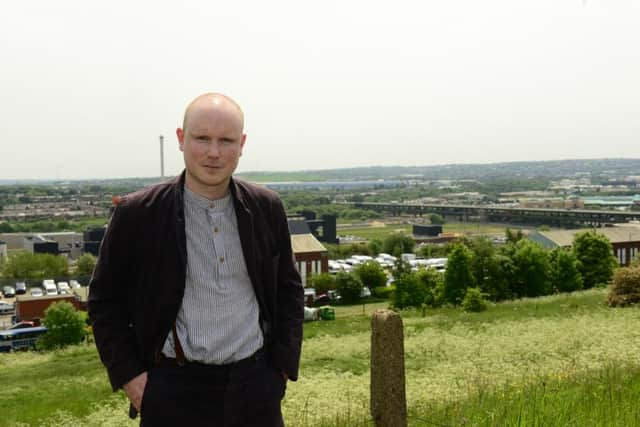How the man who did this is now creating a new work of art for Yorkshire


When it comes to turning blank canvases into works of art, Alex Chinneck never takes the most obvious route. In the past few years he has built a house out of wax bricks with the sole purpose of watching it melt, implanted a 35ft steel pylon tip first into a piece of wasteland near Canary Wharf and suspended a Corsa upside down in a car park. In 2014 he also took over a corner of Covent Garden and when the hoardings came down it revealed a building which had apparently being sliced in two - the top half being kept up seemingly by thin air.
“I am only 31. I know I look older, but honestly every project puts five years on me,” says Chinneck, whose next work might just finish him off. The Bedford-born sculptor has just been named as the man charged with creating Sheffield’s largest ever piece of public art. The £450,000 work is being funded by the power company E.ON and it will take its inspiration from the city’s history of heavy industry, including the iconic Tinsley cooling towers.
Advertisement
Hide AdAdvertisement
Hide AdFor 70 years they cast a 250ft shadow over the M1 at Medowhall, but in 2008 the power company announced they were structurally unsafe and would have to be demolished. The move prompted a backlash from many in the creative community, who called for them to be saved for the nation. The campaign gained momentum when Turner Prize winning sculpture Anish Kapoor offered his services and unveiled proposals for a tornado of smoke within the towers.


Ultimately the plans came to nothing and at 3am on the August bank holiday 2008 a few thousand gathered to watch the towers come down. Ever since there have been hopes that E.ON would find a way to give Sheffield back a landmark it can be proud of. After eight years and more meetings than anyone cares to remember, Chinneck will now be charged with that task.
“Funnily enough I found out I had been successful while I was driving up the M1. Let’s call it fate. I know it sounds odd, but as soon as I heard about the Tinsley project I felt I was born to do it. I don’t want that to sound arrogant, honestly it’s not. It’s just that my work has always had a twin focus on architecture and engineering and that’s exactly what this brief demands.
“The towers were iconic. For a lot of people seeing them on the horizon meant they were home, but they were very much a M1 experience. I think it would be wrong to create something in their image and I want this work to be more than something you drive past for 30 seconds. This really is a once in a generation chance to deliver something really special for this area.” Chinneck, who was selected from 70 other artists, has not yet nailed down what his latest work of art will look like. His first design is expected to be submitted early next year with the project earmarked for completion by summer 2018.
Advertisement
Hide AdAdvertisement
Hide Ad“I’ve got millions of ideas going on in my head, but it’s about working out which one can make the most positive contribution to Tinsley and the people who live there. There is a tendency for public art to be intellectual elitist. People who supposedly know about art tell others what they should have and if they don’t ‘get it’ it’s their fault.


“It’s a horrible philosophy and one I have never bought into. If you are going to leave a permanent mark on a place you really ought to spend time with a community and find out what it is they want. If you get it right it can create a real sense of place and the footfall can be huge. Get it wrong and it becomes a white elephant.”
Working with the same team which has successfully brought his other projects to life, Chinneck says his reputation for big, statement projects was largely accidental and began with Telling the Truth Through False Teeth (2012), where he installed 312 identically smashed windows across the derelict facade of a factory in Hackney.
“I’d had two identical windows sat in my studio for months and one day I came up with the idea of enlarging the piece and taking it outside. To be honest I didn’t think anyone would take much notice. I was really doing it for me, but when it was completed the media interest was huge. It totally took me by surprise.”
Advertisement
Hide AdAdvertisement
Hide AdSince then Chinneck has become known for his buildings which appear to float, melt or have simply been turned entirely upside down. In one of his most famous pieces, he transformed an empty house in Margate so it seemed as if the front was slipping into the street outside.


“Sometimes it feels that my role now is two percent creative and 98 per cent administrative,” he says. “With these kind of projects there are always logistical problems. When we wanted to plant the pylon into the ground we had to carry out unexploded bomb surveys and when we wanted to build a house out of wax bricks we had to ensure it would still pass normal building regulations. But we always find a way - often it involves an awful lot of concrete.”
The Tinsley Tower Art Project is linked to the wider regeneration of the Lower Don Valley and while an exact site for Chinneck’s work hasn’t yet been identified it will be a stone’s throw from the former cooling towers which is now home to E.ON’s new biomass plant.
“All our projects tend to be a collaboration between us and industry and I’m really keen to hear from manufacturers in Sheffield who want to be involved,” says Chinneck. “To be honest I would visit ever single factory in the city if that’s what it takes because while this piece has to be striking it also has to tell a story.
Advertisement
Hide AdAdvertisement
Hide Ad“A lot of my work to date has been based in London. That’s largely because that’s where the majority of the commissions are. Put simply, it’s where the money is, but I am keen to work elsewhere. Having said that I am also sensitive to the fact people might feel that this particular work should have been created by a South Yorkshire artist. I don’t have any direct ties to the area, but I do feel that we are the right people to deliver something really special. Once we have a final design, we will are also be directing a proportion of the budget towards commissioning local artists to create works in response to our work.”


While any piece of public art will inevitably have its critics, large-scale works like the Angel of the North have done much to win the public round.
“That is probably the greatest piece of commissioned art in England,” says Chinneck of Antony Gormley’s landmark work. “It took great vision to give it the go ahead, but it was a risk which paid off. Recently we have had three proposals, which were being funded by private money, rejected at the planning stage. That’s incredibly frustrating because we are passionate about the work we do and the changes it can bring to communities. We have a number of projects in the pipeline at the moment, but Sheffield is definitely the most important.”
Firms interested in being involved with the Tinsley Art Project can email [email protected]